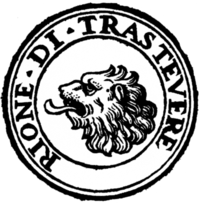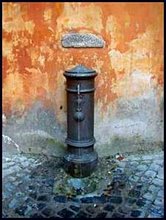Rome's Jewish community claims to be the oldest in the world, as it is known to exist since the late 2nd century BC, when slaves were brought here from Palestine, under roman rule. During the early years and throughout the Middle Ages, the roman Jews had no problems in living side by side with the local Christian population; their main activity was trade. But hard times came during the late Renaissance, when the Church of Rome, following the Protestant schism, gave a sharp turn of the screw against the non-Christian population. The newly elected pope Paul IV decided to enclose the whole Jewish community within a very small enclosed area, and issued strict discriminatory laws.
 Detail of the ghetto in a map by G.B.Falda (1676), featuring the three early gates (in red), the ones opened by Sixtus V (in blue) the Porch of Octavia (1st arrow) and the church of St.Gregory (2nd arrow on the right);a further gate was built in the 1800s on the spot marked with the 3rd arrow below
Detail of the ghetto in a map by G.B.Falda (1676), featuring the three early gates (in red), the ones opened by Sixtus V (in blue) the Porch of Octavia (1st arrow) and the church of St.Gregory (2nd arrow on the right);a further gate was built in the 1800s on the spot marked with the 3rd arrow belowThe neighborhood, known as the ghetto, comprised the few narrow streets located between piazza Giudea (no longer there) by the church of Santa Maria del Pianto, the remains of the Porch of Octavia and the river bank by the Tiber Island. Following Paul IV's bull entitled Cum nimis absurdum (literally "when too much is absurd", actually "when enough is enough"), issued in 1555, the 3,000 members of the community were forced to live within the ghetto's boundary, originally called 'the Jews' enclosure', whose total surface was about 8 acres. The dwellers were allowed to leave this neighborhood only during daytime, while from dusk till dawn the entrances to the district were closed by huge doors, watched over by guards, whose wages the same community had to pay for. Originally the gates were three, but only a few decades later, when pope Sixtus V had the ghetto slightly enlarged towards the river, their number rose to five. Neither the gates nor their doors exist any longer, but old maps still feature them quite clearly. Those who were left outside after the closing time were to face the implacable papal law court. Outside the ghetto all Jewish men had to wear a piece of yellow cloth on their hat, while women had to wear a yellow veil, or a scarf of the same colour, so to be easily recognized.
They could not own any property, the houses where they lived belonged to non-Jews, who rented them to members of the community and the only job they could live on was to sell rags.
On Saturdays, the adult members of the community had to attend the so-called compulsory preaches, sermons whose purpose was to convert them to the Christian religion; only within the ghetto's boundary, the Jews were allowed to follow their own religion.
Besides the discriminations, the ghetto's dwellers had to endure several humiliating traditions and rituals. For instance, during the celebrations for Rome's Carnival, usually held in February, a number of elderly Jews was forced to race along the central high street, while the crowd mocked them, and threw all sorts of trash; this custom was later turned into a horse race.
 Nowdays the ghetto's gates no longer exist, but the hinges of one door (far left) are still visible in via della Reginella
Nowdays the ghetto's gates no longer exist, but the hinges of one door (far left) are still visible in via della ReginellaOnly in 1870, when the papal rule over Rome came to an end, the doors of the hideous enclosure were finally opened. The roman Jews were then let free to leave this area, and were given once again the same civil rights as the Christian citizens. A few restaurants in the neighborhood keep alive Jewish-roman cooking, a very old tradition which blends typical Jewish dishes with roman ones, such as the famous fried artichokes. The so-called "fagottari", patrons who used to carry their own food in a bundle (fagotto), thus ordering only wine, are no longer seen, as this custom has died out (since the moment that a tradition never dies totally......you can still today carry your own food and ordering wine in some wine cellars in Frascati).
By the turn of the 20th century, not long after the ghetto had been opened, some of the original houses of the district were taken down, the streets were enlarged, and new buildings rose. But the surviving lanes of this neighborhood, a silent nook embedded in the heart of bustling Rome, have maintained their magical atmosphere, a very particular blend of history, architecture and tradition (too see photos look here).

Via del Portico d'Ottavia on one side still hasa row of ancient houses (15th-16th centuries)
Take time to visit the Ghetto & eat kosher is a really nice experience to have!
OPS...don't forget to try the most appreciated pastry called "Il Forno del Ghetto"!


















